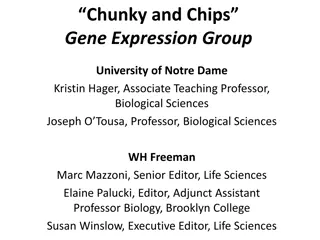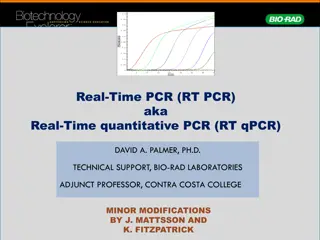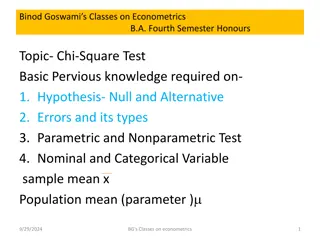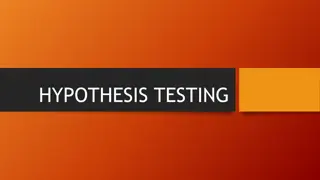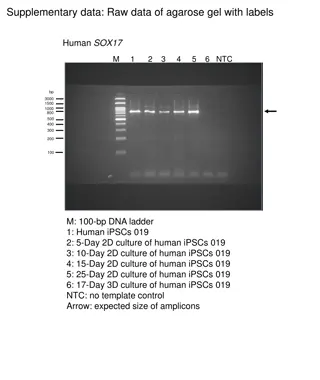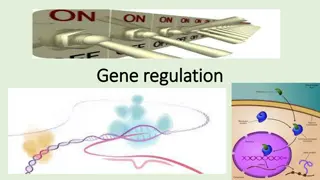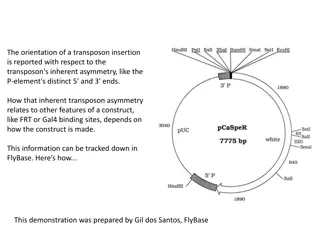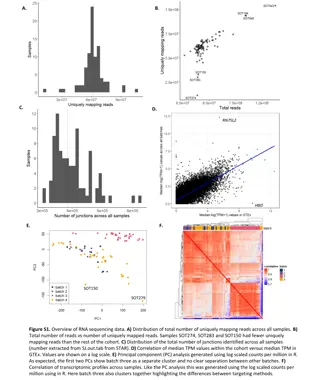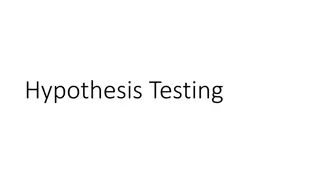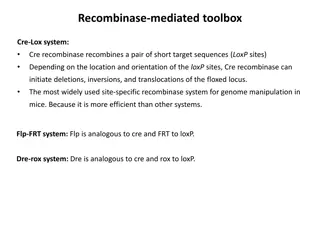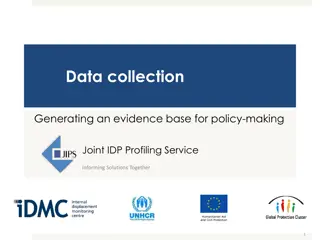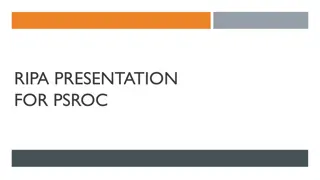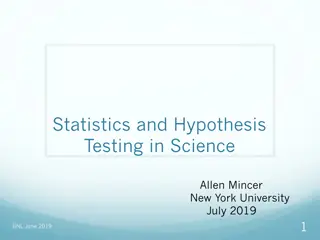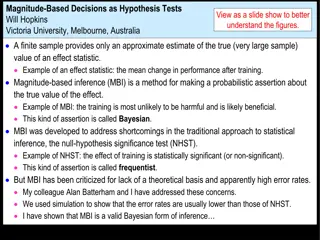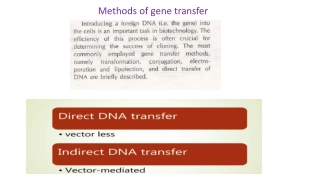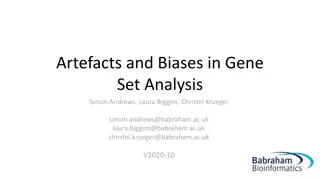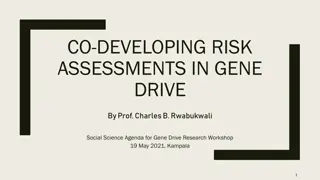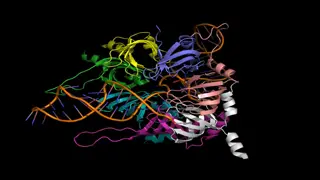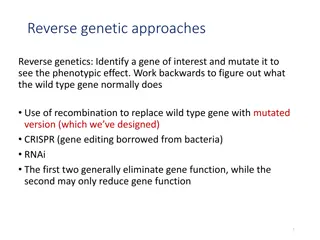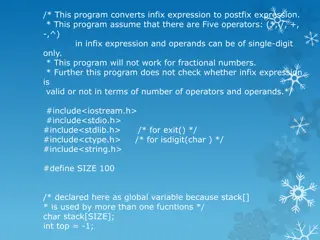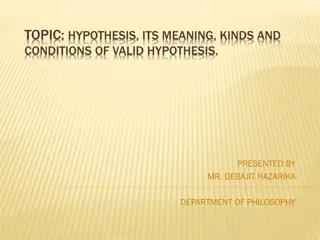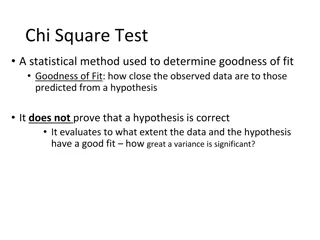Basics of Hypothesis Testing in Gene Expression Profiling
The lecture covers the essential aspects of hypothesis testing in gene expression profiling, emphasizing experimental design, confounding factors, normalization of samples, linear modeling, gene-level contrasts, t-tests, ANOVA, and significance assessment techniques. Practical insights are shared on avoiding confounding biological and technical factors, assessing treatment effects, performing linear modeling for gene expression analysis, conducting t-tests for group differences, and utilizing ANOVA for multiple treatments. Understanding these fundamentals is crucial for accurate interpretation of gene expression data in research studies.
- Gene expression profiling
- Hypothesis testing
- Experimental design
- Confounding factors
- Linear modeling
Download Presentation

Please find below an Image/Link to download the presentation.
The content on the website is provided AS IS for your information and personal use only. It may not be sold, licensed, or shared on other websites without obtaining consent from the author. Download presentation by click this link. If you encounter any issues during the download, it is possible that the publisher has removed the file from their server.
E N D
Presentation Transcript
Summer Institutes of Statistical Genetics, 2020 Module 6: GENE EXPRESSION PROFILING Greg Gibson and Peng Qiu Georgia Institute of Technology Lecture 2: HYPOTHESIS TESTING greg.gibson@biology.gatech.edu http://www.cig.gatech.edu
Basics of Experimental Design: Confounding At the design step, avoid confounding biological factors: - don t contrast bloods from young males and old females - don t contrast hearts from normal mice and livers from obese ones as far as possible, balance all biological factors Be aware of the potential for technical confounding: - date of RNA extraction or sequencing run - batch of samples (particularly for microarray studies) - person who prepared the libraries - SE or PE, read length and quality of reads - quality of RNA (RIN = Bioanalyzer RNA Integrity Number)
Fundamentals of Hypothesis Testing: Linear Modeling 1. Normalize the samples: log(fluorescence) = + Array + Residual log(CPM) = (read counts + 1) 106 / total read counts OR variance transforms, OR supervised methods 2. For each gene, assess significance of treatment effects on the Residual or the log(CPM) (ie. expression level) with a linear model: Expression = + Sex + Geno + Treat + Interact + Error OR likelihood ratio test or Wilcoxon Rank-Sum test, etc
Fundamentals of Hypothesis Testing: Gene-level Contrasts 1. Generally we are interested in asking whether there is a significant difference between two or more treatment group(s) on a gene-by-gene basis 2. For a simple contrast, we can use a t-test to test the hypothesis. Significance is always a function of: 1. The difference between the two groups: [5,6,4] vs [7,5,6] has a diff of 1 2. The variance within the groups: [2,5,8] vs [3,6,9] does as well, but is less obvious 3. The sample size: [5,6,4,4,6,5] vs [7,5,6,5,6,7] is better 3. For contrasts involving multiple effects, we usually use General Linear Models in the ANOVA framework (analysis of variance: significance is assessed as the F ratio of the between sample to residual sample variance. 4. edgeR uses limma to perform One-Way ANOVAs. This likelihood framework is very powerful, but constrains you to contrast treatments with a reference 5. Robust statistics (eg using lme4) also allow you to evaluate INTERACTION EFFECTS, namely not just whether two treatments are individual significant, but also whether one depends on the other 6. Given a list of p-values and DE estimates, we need to evaluate a significance threshold, which is usually done using False Discovery Rate (FDR) criteria, either Benjamini-Hochberg or a qvalue
Fundamentals of Hypothesis Testing: t-tests and ANOVA A two-sample t-test evaluates whether the two population means differ one another, given the pooled standard deviations of the sample and the number of observations: F-statistics generalize this approach by asking whether the deviations between samples samples are large relative to the deviations within samples. The larger the difference between the means, the larger the F-ratio, hence significance is evaluated by contrasting variances. Between Within Generally we start by evaluating whether there is variation among all the groups, and then test specific post-hoc contrasts. With multifactorial designs you also should be aware of the difference between Type I and Type III sums of squares, namely univariate and conditional tests.
Volcano Plots: Significance against Fold-Change The Significance Threshold at NLP = 5 (p<10-5) is conservatively Bonferroni corrected for 5,000 genes. While significance testing allows for inclusion of more genes that have small fold-changes (sector B), you need to be aware that there is also variation in the estimation of the denominator (variance) which can inflate NLP values.
FDR and qValues Traditional B-H False Discovery Rates simply evaluate the difference between the observed and expected number of positives at a given threshold, in order to estimate the proportion of false positives. Eg. In 10,000 tests, you expect 100 p-values < 0.01. If you observe 1000, then the FDR is 100/1000 = 10%. The q-value procedure estimates the proportion of true negatives from the distribution of p-values. https://www.bioconductor.org/packages/release/bioc/html/qvalue.html
Hypothesis Testing in edgeR If you compare the output of edgeR to those of a t-test or F-test, particularly for small n, you will often get very different results. There are at least 4 reasons for this. 1. edgeR performs a TMM normalization. Since RNASeq generates counts, we adjust for library size by computing cpm (counts per million). If a few high abundance transcripts vary by several percent, they throw off all the other estimates. TMM fixes this. 2. edgeR shrinks the variance of low abundance transcripts by fitting the distribution to the negative binomial expectation. Basically it adds values to account for sampling error at the low end so that comparing 0, 1 and 2 is more like comparing 10, 11 and 12. 3. edgeR also employs a powerful within-sample variance adjustment in its GLM fitting, with the result that it puts much more weight on fold-change than standard F-tests. 4. For a one-way ANOVA the approaches are similar (though you need to be careful about whether you fit an intercept, which means you compare multiple samples to a reference rather than to one another). For more complicated analyses involving two or more factors, nesting, and random effects, the modeling frameworks are really quite different. I prefer to run ProcGLM or ProcMIXED in SAS or JMP-Genomics; the equivalent in R is lme4, but needs looping of the code.




